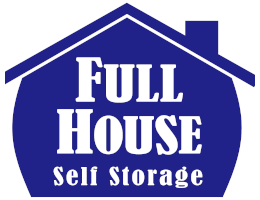 Storage Tips
Storage Tips

WARNING: NEVER STORE COMBUSTIBLES.
OTHER PROHIBITED ITEMS INCLUDE: Propane Bottles, other Compressed Gases
(Acetylene, Oxygen, etc.), Ether, Carburetor Cleaner, Acetone, Mineral Spirits,
Oil-Based Paints or Paint Thinners, Solvents, Acids, Batteries, Gasoline, Oil,
Kerosene, Lamp Oil, Fertilizers, Gun Powder, Primers, Chemicals, or PERISHABLES.
Throw away anything that might rot or cause a fire. Don't risk your possessions!
Follow these simple packing tips to stay organized, avoid damage to your possessions, and make the maximum use of your unit:
Before beginning:
Gather plenty of corrugated cartons, packing paper, sealing tape, a notepad & pen,
and a large marker to label your boxes.
Label boxes on top and all four sides.
Number the boxes and make a list of what is inside each box. The list will come
in handy when you need to locate your goods. Fill all boxes to capacity
(especially those on the bottom level). Partially full cartons are more likely
to collapse and tip over.
Appliances:
Make sure appliances are clean and completely dry before storage. Tape doors
shut while moving but wedge doors open slightly in storage to prevent odors and
mildew. Put a rolled up newspaper in the door frame of your refrigerator / freezer
and then tape the door “closed” with the newspaper holding it open slightly for
air circulation. Items can also be stored on top of appliances. That might be
a good place for boxes of fragile items so they don’t get crushed. Make sure
that stoves and cookware are cleaned before they are stored. Large bulky items
such as bedding, towels, clothing and pillows can also be stored in refrigerators,
washers, dryers to conserve space (be sure to leave an air gap).
Heavy items:
like books or tools should be packed in small boxes so they are easy to lift. Heavy items should also be put on the bottom of any stacked items.
Books:
Pack books flat (not on end which may cause damage to the spines). Books are
extremely heavy, so don't pack too many in one box or mix them with fragile items.
Pack books in small cartons to keep the weight under 30 pounds for easier lifting.
Use similar sized cartons for better storage / stacking.
Furniture:
Disassemble as much furniture as possible. Tables, legs, etc. Wrap disassembled
pieces with pads or paper. Tape the pieces together if possible. This will save
you space and help you protect your furniture. Place a pallet, corrugated
cardboard mat, or plastic sheet on the floor and stand sofas and mattresses on
end. If a table will not disassemble, be sure to store items on top and
underneath it. Use dresser tops for stacking cartons and dresser drawers for
linens or small, delicate items. Keep upholstery off the concrete floor. Stack
chairs "seat to seat" or placed upside down on tables which cannot be disassembled.
Place dust covers on your furniture. Bed sheets work fine and can be washed later.
Fragile / Breakable Items:
Wrap glass and other breakables in bubble wrap. Store breakables with linens
for extra protection. Do not place your fragile items on the bottom level of your
unit. Some fragile items can be stored inside refrigerators, freezers, washers,
dryers, ovens or dresser drawers for extra protection.
Mattresses:
Protect mattresses and fabric covered furniture with specially designed plastic
covers or wrap them in heavy plastic. If not, place sheets, covers, packing
blankets or plastic bags on mattresses to help keep them clean.
Blankets, Draperies and Clothing:
Pack them on a hanger in a wardrobe box. If wardrobe boxes aren't available,
place large plastic trash bags over clothes or other items on hangars.
Transport them flat in stacks, then hang them from the exposed purlins on
ceilings or walls.
DO NOT DRILL HOLES ANYWHERE IN THE STORAGE UNIT
Dishes and Glassware:
Use lots of paper to pack your dishes. Wrap each dish and glass separately and
cushion them with crumpled paper. Use sturdy cartons and keep the weight under 30 pounds.
Mirrors and Paintings:
Large works should be stored in specially designed boxes. Wrap smaller pictures
in paper pads or blankets and pack in mirror cartons. Stand both on edge.
Never store mirrors or paintings flat.
Photos:
Old photographs tend to curl over time. To keep them flat, place them between
two pieces of cardboard and tape them together. We do not recommend storing
irreplaceable photos or negatives in your storage unit. Old negatives take up
very little space. Consider keeping them with you.
Windows and Screens:
These items should be stored on edge, not flat.
Electronics:
To minimize dust damage, wrap electronics in linens or clean paper. Cold items
will cause condensation when you bring them into your warm home. That internal
condensation can short out your electronic components. If you store electronics
in unheated units in winter, be sure to allow sufficient time (hours or even days)
for items to dry out at room temperatures before plugging them in or turning them on.
Lamps:
Pack lamp shades in individual boxes with plenty of clean paper or clothing for
padding. Nest your shades together if possible. Pad them well. You can also
protect lamps in appliances or bureau drawers.
Tables:
Remove the legs from large tables, if possible. Disassemble to conserve storage
space. Wrap with furniture pads or blankets to protect from soil and scratches.
Wrap the legs together with packing paper and, if possible, tape them to the
protective wrap placed around the corresponding item. Tie and pad extra leaves
together. Store table tops on edge and pad with paper or blankets.
Chests and Dressers:
Use the drawers to store small and fragile items. Clothing makes excellent packing material.
Lawn Mowers:
Drain gasoline from all small engines.
Vehicle:
Place a protective drip pan under the vehicle to protect concrete floors.
Do not store with full gas tanks. The gasoline can expand and spill.
Neither should you store them with empty tanks. The fumes are volatile.